The OnePlus One Review
by Joshua Ho on November 19, 2014 8:00 AM EST- Posted in
- Smartphones
- Android
- Mobile
- OnePlus
Battery Life
At this point, battery life is one of the number one priorities for a phone. While in 2013 our primary tests consisted of the web browsing test and video playback tests, we've expanded our suite to include Basemark OS II and GFXBench to simulate intensive general usage and gaming, respectively. For all of our tests in which the display is on, we calibrate the brightness of full white to be 200 nits in order to standardize and attempt to control for extraneous variables as much as possible. While this may seem arbitrary, it's important to do so to draw real conclusions about which phone has better battery life. 200 nits on a phone can be as low as 50% and as high as 90%, so setting a standardized brightness percentage would not be an effective method of controlling for display brightness. With that in mind, let's get to the battery life tests.

Here, we see that the OnePlus One takes the number three spot for battery life amongst phones and phablets. This is definitely a great result to start with, and is a solid 20% higher than the One (M8). However, the Huawei Ascend Mate 2 continues to hold its position with a long lead over just about anything else available in the market today.
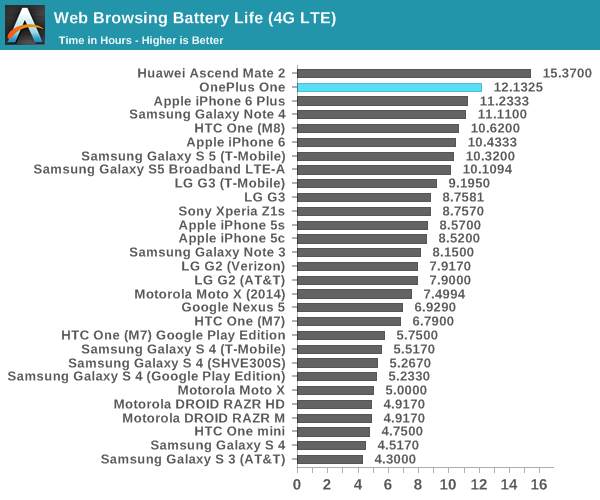
We can see a similar story in LTE web browsing battery life. However, the OnePlus One manages to close up the lead that the Ascend Mate 2 holds in WiFi browsing. It's likely that the 28nm LP process and lack of envelope tracker is responsible for closing the gap in this regard. It's interesting to see how the iPhone 6 Plus trails behind the OnePlus One here, but it's likely that this difference is due to the fact that the iPhone 6 Plus has an off-die modem compared to the OnePlus One's on-die modem.
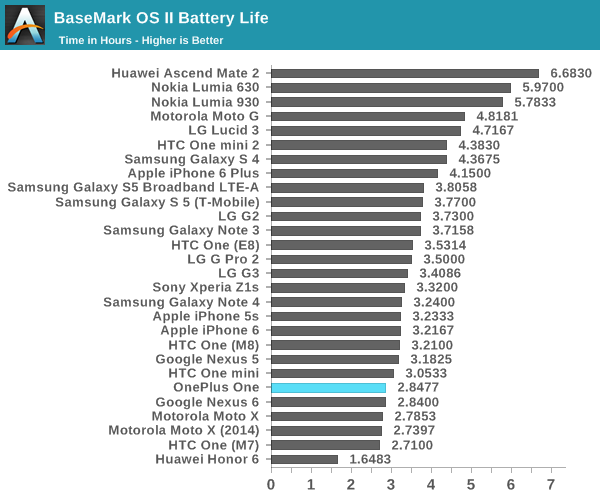

White battery life tends to fall towards the bottom here, we can see that the reality is that the OnePlus One performs quite well, which indicates that there's relatively little throttling to speak of and that the OnePlus One is simply doing well by sustaining high levels of performance.
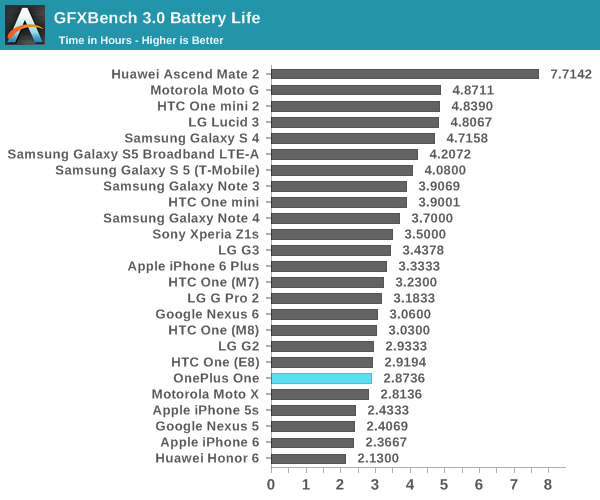
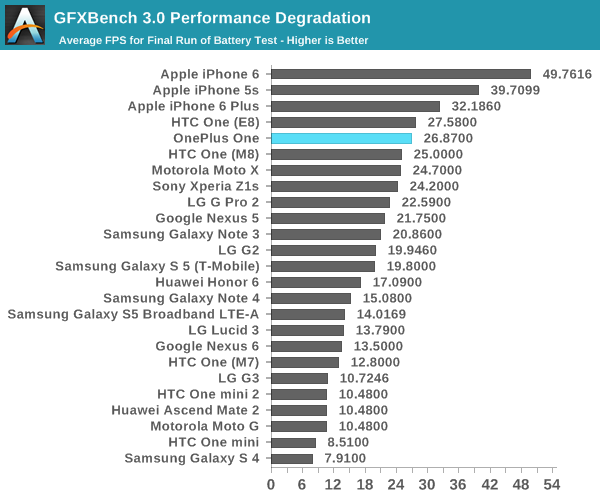
We see the same story in the GFXBench rundown. The OnePlus One manages to set a new record for final run FPS among phones and phablets, although battery life is near the bottom of the pack. It seems that if there's any one reason for the escalating display size wars, it is to increase battery life. While by no means a clear order, we can see that the larger battery more than compensates for the larger display of the OnePlus One. This makes sense, as a phone should have a fixed size circuit board. Therefore, by increasing display size the circuit boards become smaller relative to the rest of the phone, and all of the area opened up by increasing the size of the phone can be taken up by the battery. Overall, the OnePlus One is almost as good as it gets for battery life in a phone, with excellent sustained performance under load.
Charge Time
To really have a holistic understanding of battery life, we must also take a look at charge time. While battery life can be the only determinant of mobility, in cases where usage is heavy enough that the battery or multiple batteries have to be charged, charge time can become incredibly important. To this end, OnePlus includes a 5V, 2.1A charger in the box to quickly charge the rather large 11.78 WHr battery.
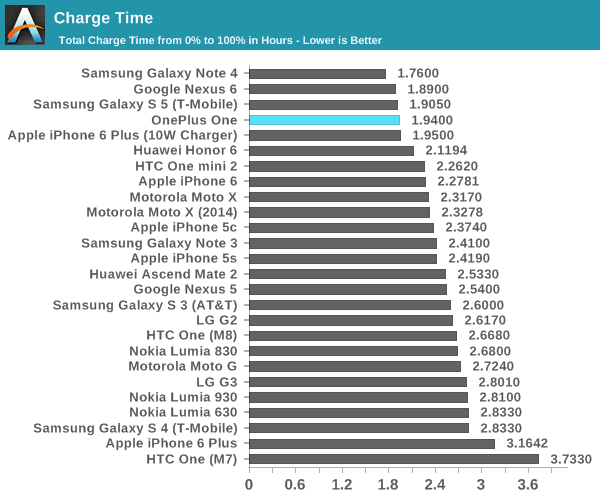
Somewhat surprisingly, the OnePlus One does a great job in this test, coming quite close to other devices with QC 2.0 fast chargers like the Galaxy Note 4 which is definitely good to see. Overall, this makes the OnePlus One one of the best phablets on the market for battery life.










148 Comments
View All Comments
Iseek1 - Friday, November 21, 2014 - link
@Joshua Ho a lot of people are amazed / confused over the battery test results, the incredible high numbers for screen on time and battery life in general per these tests, would you possibly be able to go into more detail as to how these tests are done?dragospascu - Saturday, November 22, 2014 - link
glad that my irk with benchmarking in balance mode was addressed ; also the size "issue" :)i have it for 2 months now and can't let it rest.....my nexus 7 is full of dust :)
i just hope they'll manage to ramp up production so all other manufacturers will be forced to reconsider their profit margins. i think everybody should cheer them up :)
shainawilliams1992 - Saturday, November 22, 2014 - link
OnePlus One is now on sale only at http://tinyurl.com/mrq34ostheduckofdeath - Saturday, November 22, 2014 - link
" While contrast with viewing angle changes isn't as good as AMOLED panels, I don't see any color shifting with viewing angle changes. This seems to remain an advantage of IPS panels for now."You know you're reading a review on iAnandtech when the writers tries to find every little scrap to be able to pretend LCD is on par with AMOLED in 2014.
Socius - Saturday, November 22, 2014 - link
IPS displays are actually superior to amoled with the exception of black levels and contrast...theduckofdeath - Thursday, November 27, 2014 - link
The extreme difference in dynamic range (by a factor of 1000 to 1) makes the theoretical minute differences in "colour accuracy" that Anandtech WRONGLY finds in their comparisons, completely irrelevant.Anandtech's flawed tests has often been openly criticized by professional display testers as being inaccurate. For instance by Displaymate, which all manufacturers use to test and calibrate their displays.
AnnonymousCoward - Saturday, November 22, 2014 - link
The color white is still better on LCD than OLED. And OLED phosphors age.theduckofdeath - Thursday, November 27, 2014 - link
I have never, ever had any issues with aging of AMOLED displays. I really think you need to update your sources. The absolute first generation of OLED had aging issues. That was 6-7 years ago.LCD displays age and bleach, too. My old laptop (which is around 4 years) with an LCD has issues showing the difference in low contrast areas, which is a big problem with all these modern/material themed sites and apps these days.
AnnonymousCoward - Friday, November 28, 2014 - link
> you need to update your sourcesMy source is myself! My 2.5 year old Samsung phone has faint spots all over that are marginally visible when the whole screen is a dark color.
pliablemoosethebanned - Saturday, November 22, 2014 - link
I've had a couple of OPO's, and thought they were a great phone, particularly when you factor in the price.